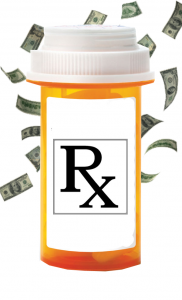Soaring drug prices have grabbed headlines over the past couple of years, including the skyrocketing cost of an AIDs drug from $13.50 to $750, EpiPen’s massive hike, the spike in insulin costs, and the escalation of the costs of other lifesaving treatments. In these days of sky-high drug costs, Medicare recipients, particularly the 90% on a fixed income, are looking to get their prescription drug costs under control.
So, if you have a Medicare Part D prescription drug plan, what can you do to get your costs under control? Here are some tips for “what if” situations.

MEDICATION NOT COVERED BY YOUR PART D PLAN?: TIP #1
What if you have a medication that is not covered by your Medicare Part D prescription drug plan? In that case, you can use a prescription drug discount card to help out. While you cannot use a discount card in conjunction with a Part D plan, you can use it on a medication or two (or three, etc.) which is not covered by a Part D plan. (In other words, you can’t have two things (such as a plan and a discount card) paying for the same medication.) There are a few of these cards on the market.
MEDICATION NOT COVERED BY YOUR PART D PLAN?: TIP #2
Another approach to take if you have a medication that is not covered by your Part D prescription drug plan is to ask your doctor to make an appeal to your Part D drug plan. If your doctor demonstrates to your drug plan that your uncovered medication is necessary for you (such as, if you have tried other medications and found they did not do what your uncovered medication does for you), oftentimes your Part D drug plan will make an exception and cover your medication. However, even if it does, some Part D plans have a rule that an exception medication will be covered at a tier 4 level. (Tier 4 is the second most expensive tier, with tier 5 being the highest.)
Compare Medicare Plans now.
MEDICATION NOT COVERED BY YOUR PART D PLAN?: TIP #3
Finally, if you have a medication not covered by your Part D drug plan, you can ask your doctor to prescribe a medication that IS covered by your plan. But, as you are well aware, not all medications are created equal, meaning that even if your doctor can come up with a medication of a similar classification that is covered by your Part D prescription drug plan, that doesn’t mean it will work well for you. If not, see the tips above.
23 PLANS: TIP #4
Even if all of your meds are covered by your Part D drug plan, you could still have significant out-of-pocket costs from your medications, such as high deductibles, copays, etc. This is where it pays to have an agent who will shop your medications with ALL of the drug plans available. For example, in East Texas, there are currently twenty-three Part D prescription drug plans available; and they are all different from one another. You could literally shop one medication with these plans and get twenty-three different results—different premiums, deductibles, and copays. The point is: It pays to shop. Don’t settle for the same plan year after year when, by shopping, you could potentially save a significant amount of money.
Keep in mind that the best plan for you is determined by the combination of medications you are taking. If your combination changes—that is, if your doctor eliminates from, or adds to, your list of medications—then the best plan for you changes. In addition, Part D plans change from year to year. So, the moral of this story is: It pays to shop your medications each year.
AVOID THIS MISTAKE: TIP #5
By the way, don’t make the mistake (as many Medicare recipients do) of simply choosing the plan with the lowest premium. That could be a major mistake. Oftentimes, the lowest premium Part D plans do fine with tier 1 medications but do not do well with tier 2, 3, and 4 medications. So, while saving premium dollars on a plan like that, you may be way overpaying on your copays.
“RECRUIT” AN ANNUAL SHOPPER: TIP #6
Based on this background, here is another tip: Get with a reputable insurance agency who will shop your medications for you. Most agents don’t want to shop your medications as it doesn’t pay for them to do so. However, there are a few agents who would be willing to shop your meds if you get a Medicare supplement with them. Even if you have a supplement currently, it may even pay for you to pay a couple of dollars more per month in premium in order to “hire” an agent who will shop your medications for you year after year.
Compare Medicare Plans now.
DON’T FORGET THE OBVIOUS: TIP #7
Finally, don’t forget that many medications have a generic equivalent that could save you money. If you are taking medications that have generic equivalents, why not try the generics? If they work as well, why take the name brands? In most cases, you shouldn’t notice a difference between the name brand and its generic. Switching to generics could save you a lot of money on an annual basis.
